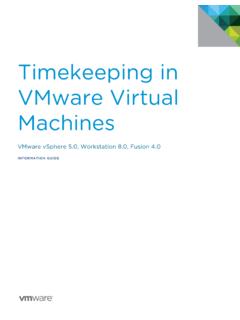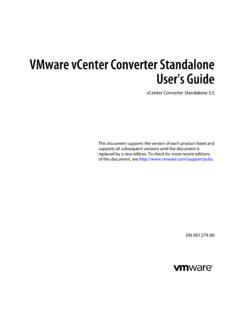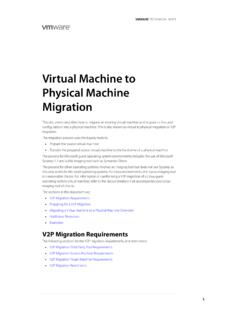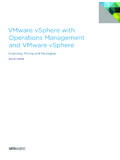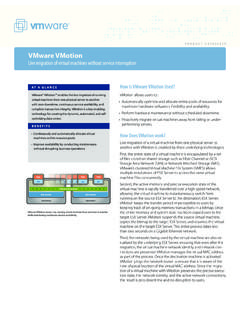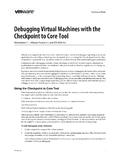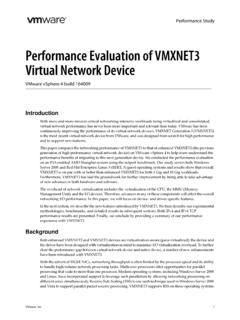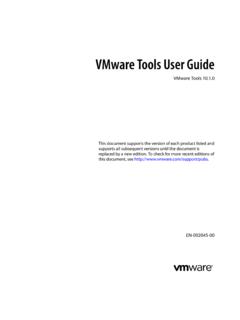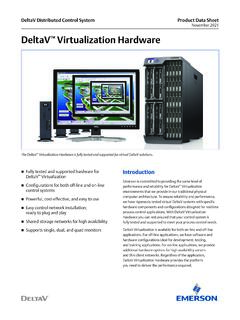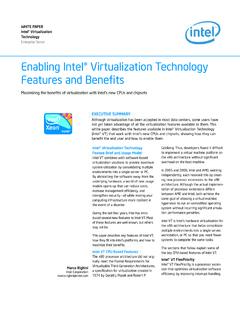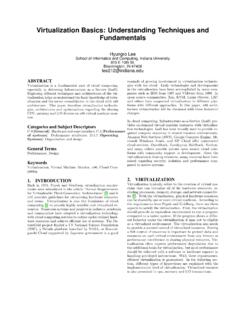Transcription of Vitualization Overview wp eng Q206 - VMware
1 1 VMware WHITE PAPERWHITEPAPERV irtualizationOverview2 VMware WHITE PAPERT able of ContentsIntroduction ..3 virtualization in a Nutshell ..3 virtualization Approaches ..4 virtualization for Server Consolidation and Containment ..7 How virtualization Complements New-Generation Hardware ..8 Para- virtualization ..8 VMware s virtualization Portfolio ..9 Glossary ..103 VMware WHITE PAPERI ntroductionAmong the leading business challenges confronting CIOs and IT managers today are: cost-effective utilization of IT infrastruc-ture; responsiveness in supporting new business initiatives; and flexibility in adapting to organizational changes. Driving an additional sense of urgency is the continued climate of IT budget constraints and more stringent regulatory requirements. virtualization is a fundamental technological innovation that allows skilled IT managers to deploy creative solutions to such business OverviewVirtualization in a NutshellSimply put, virtualization is an idea whose time has come.
2 The term virtualization broadly describes the separation of a resource or request for a service from the underlying physical delivery of that service. With virtual memory, for example, computer software gains access to more memory than is physically installed, via the background swapping of data to disk storage. Similarly, virtualization techniques can be applied to other IT infrastructure layers - including networks, storage, laptop or server hardware, operating systems and blend of virtualization technologies - or virtual infrastruc-ture - provides a layer of abstraction between computing, storage and networking hardware, and the applications running on it (see Figure 1). The deployment of virtual infrastructure is non-disruptive, since the user experiences are largely unchanged. However, virtual infrastructure gives administrators the advantage of managing pooled resources across the enter-prise, allowing IT managers to be more responsive to dynamic organizational needs and to better leverage infrastructure 1: virtualization After virtualization : Hardware-independence of operating system and applications Virtual machines can be provisioned to any system Can manage OS and application as a single unit by encapsulating them into virtual machinesBefore virtualization .
3 Single OS image per machine Software and hardware tightly coupled Running multiple applications on same machine often creates conflict Underutilized resources Inflexible and costly infrastructure VMware WHITE PAPERU sing virtual infrastructure solutions such as those from VMware , enterprise IT managers can address challenges that include: Server Consolidation and Containment Eliminating server Server Consolidation and Containment Eliminating server Server Consolidation and Containmentsprawl via deployment of systems as virtual machines (VMs) that can run safely and move transparently across shared hardware, and increase server utilization rates from 5-15% to 60-80%. Test and Development Optimization Rapidly provisioning test and development servers by reusing pre-configured systems, enhancing developer collaboration and standard-izing development environments.
4 Business Continuity Reducing the cost and complexity of Business Continuity Reducing the cost and complexity of Business Continuitybusiness continuity (high availability and disaster recovery solutions) by encapsulating entire systems into single files that can be replicated and restored on any target server, thus minimizing downtime. Enterprise Desktop Securing unmanaged PCs, work-stations and laptops without compromising end user autonomy by layering a security policy in software around desktop virtual machines. Figure 2: virtualization ArchitecturesVirtualization ApproachesWhile virtualization has been a part of the IT landscape for decades, it is only recently (in 1998) that VMware delivered the benefits of virtualization to industry-standard x86-based platforms, which now form the majority of desktop, laptop and server shipments.
5 A key benefit of virtualization is the ability to run multiple operating systems on a single physical system and share the underlying hardware resources known as partition-ing. Today, virtualization can apply to a range of system layers, including hardware-level virtualization , operating system-level virtualization , and high-level language virtual machines. Hardware-level virtualization was pioneered on IBM mainframes in the 1970s, and then more recently Unix/RISC system vendors began with hardware-based partitioning capabilities before moving on to software-based Unix/RISC and industry-standard x86 systems, the two approaches typically used with software-based partitioning are hosted and hypervisor architectures (See Figure 2). A hostedapproach provides partitioning services on top of a standard operating system and supports the broadest range of hardware configurations. In contrast, a hypervisor architecture is the first hypervisor architecture is the first hypervisorlayer of software installed on a clean x86-based system (hence it is often referred to as a bare metal approach).
6 Since it has direct access to the hardware resources, a hypervisor is more efficient than hosted architectures, enabling greater scalability, robustness and Architecture Installs and runs as an application Relies on host OS for device support and physical resource managementBare-Metal (Hypervisor) Architecture Lean virtualization -centric kernel Service Console for agents and helper applications45 VMware WHITE PAPERH ypervisors can be designed to be tightly coupled with operat-ing systems or can be agnostic to operating systems. The latter approach provides customers with the capability to implement an OS-neutral management paradigm, thereby providing further rationalization of the data partitioning is another approach, whereby many applications share a single operating system, but this offers less isolation (and higher risk) than hardware or software partitioning, and limited support for legacy applications or heterogeneous environments.
7 However, various partitioning techniques can be combined, albeit with increased , virtualization is a broad IT initiative, of which partitioning is just one facet. Other benefits include the isolation of virtual machines and the hardware-independence that results from the virtualization process. Virtual machines are highly portable, and can be moved or copied to any industry-standard (x86-based) hardware platform, regardless of the make or model. Thus, virtualization facilitates adaptive IT resource management, and greater responsiveness to changing business conditions (see Figures 3-5).To provide advantages beyond partitioning, several system resources must be virtualized and managed, including CPUs, main memory, and I/O, in addition to having an inter-partition resource management capability. While partitioning is a useful capability for IT organizations, true virtual infrastructure delivers business value well beyond that.
8 Figure 3: Traditional Infrastructure6 VMware WHITE PAPER Figure 5: VMware Virtual Infrastructure Figure 4: Virtual Infrastructure Hardware/Software SeparationInfrastructure is what connects resources to your Infrastructureis a dynamic mapping of your resources to your : decreased costs and increased efficiencies and responsivenessTransforms farms of individual x86 servers, storage, and networking into a pool of computing resources 7 VMware WHITE PAPERV irtualization for Server Consolidation and ContainmentVirtual infrastructure initiatives often spring from data center server consolidation projects, which focus on reducing existing infrastructure box count , retiring older hardware or life-extend-ing legacy applications.
9 Server consolidation benefits result from a reduction in the overall number of systems and related recurring costs (power, cooling, rack space, etc.)While server consolidation addresses the reduction of existing infrastructure, server containment takes a more strategic view, server containment takes a more strategic view, server containmentleading to a goal of infrastructure unification. Server contain-ment uses an incremental approach to workload virtualization , whereby new projects are provisioned with virtual machines rather than physical servers, thus deferring hardware is important to note that neither consolidation nor contain-ment should be viewed as standalone exercise. In either case, the most significant benefits result from adopting a total cost-of-ownership (TCO) perspective, with a focus on the ongoing, recurring support and management costs, in addition to one-time, up-front costs. Data center environments are becoming more complex and heterogeneous, with correspondingly CPUNICDiskMemoryHardwareBlade HardwareOther HardwareVMVMVMVMV irtualCenterDistributed ServicesESX ServerVMotionProvisioningConsolidated BackupDRSDASVMMVMMVMMVMMR esourceManagementVMFSMPIOCPUV irtualizationMMUV irtualizationI/OVirtualizationVirtualNet workingOther EnterpriseFeaturesManagementandDistribut edVirtualizationServicesMonitorEnterpris e-ClassFeaturesHypervisorHardware Certifi cationhigher management costs.
10 Virtual infrastructure enables more effective optimization of IT resources, through the standardization of data center elements that need to be alone does not deliver server consolidation or containment, and in turn consolidation does not equate to full virtual infrastructure management. Beyond partition-ing and basic component-level resource management, a core set of systems management capabilities are required to effectively implement realistic data center solutions (see Figure 6). These management capabilities should include comprehensive system resource monitoring (of metrics such as CPU activity, disk access, memory utilization and network bandwidth), automated provisioning, high availability and workload migration 6: Virtual Infrastructure Management8 VMware WHITE PAPERHow virtualization Complements New-Generation Hardware Extensive scale-out and multi-tier application architectures are becoming increasingly common, and the adoption of smaller form-factor blade servers is growing dramatically.
